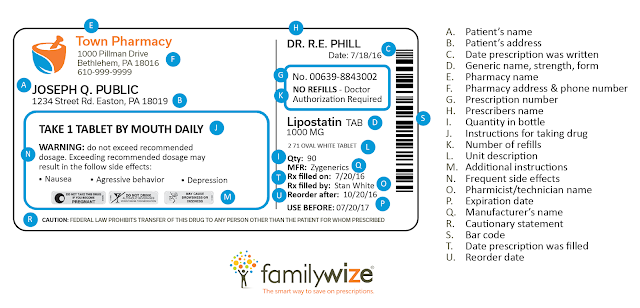 NEXT ARTICLE
NEXT ARTICLE
NEXT ARTICLE
3 Things to Check on Your Prescription Label Every Time
If you are like most people, when you pick up a new prescription at the drug store, you smile as you take the bag from the pharmacist, show your medication savings card , pay, and leave … never actually opening the bag until you get home. What you may not realize is that prescription labels (required by federal law) provide a wealth of information. By quickly reviewing the label for three key things before you leave the pharmacy counter, you can help to ensure that your prescription will be administered and dosed correctly – keeping you and your family safe.
Your Prescription Drug Label – Three Things You Should Always Check:
It sounds so simple, but it takes less than one second for you to check and make sure that the person behind the counter didn’t accidentally give you someone else’s prescription by mistake. Medication errors aside, a misspelled name or incorrect address can cause huge insurance headaches – better to catch and correct the issue before you leave the pharmacy.
2. Your dosing and storage instructions
For most people, the dosing instructions are the only thing they read on a prescription drug label – and usually not until they’re ready to take it for the first time. Check the instructions before you walk away from the counter to see if you have any questions about how your medication should be administered. As a bonus, if the pharmacist sees you reading the label, they might offer additional tips that are not included on the printout (like that amoxicillin doesn’t require refrigeration, but often tastes better to toddlers when it is kept very cold).
3. Your refill instructions
Many pharmacists will tell you that the majority of the questions they answer on any given day are related to prescription refills. Most prescription drug labels include this information on the bottle. Take a quick look at the label to confirm those details and ask if they aren’t immediately clear. You will save everyone some time when your current course of medication runs out.
Check out our graphic below for additional information about what is included on a prescription drug label and be sure to ask your pharmacist if you have any questions.
Looking to save a few dollars on your next trip to the pharmacy? Regardless of your insurance situation, the Free FamilyWize Prescription Discount Card can help you to save money on your family’s prescription drugs. Get your own free prescription savings card or download the app today.
Sources :
Featured Post
Sign Up
Like our articles?
Sign up to receive our monthly newsletter, offering the latest health & wellness news and savings tips, delivered right to your inbox.
More






